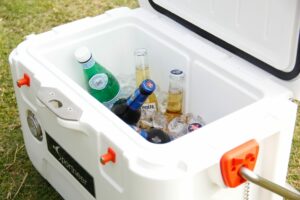Along with summer, the delicious smell of barbecue is also in the air. However, balmy temperatures are unfortunately ideal conditions for bacteria to multiply rapidly. So, how do you prevent the line for burgers from turning into a queue for the toilet? These tips from the Federal Agency for the Safety of the Food Chain (FASFC) can help.
Summer is the time of year to enjoy the sun, each other's company and a delicious barbecue with friends and family. Marinated ribs, grilled sardines or a stuffed portobello mushroom, the opportunities are endless. Unfortunately, we humans are not the only ones who love those circumstances.
In hot weather, bacteria and other microorganisms can multiply rapidly, especially if there is food involved. How can you avoid possible contamination with salmonella, campylobacter or other germs?
From store to table
It starts with the groceries you buy in the store. In addition to one or more regular reusable bags, also bring cool bags to store refrigerated products safely. Preferably use separate bags for fruit and vegetables on the one hand and fish and meat on the other to avoid possible cross-contamination. If possible, try to put fish, meat and poultry in separate bags. Always buy meat and fish at the end of your visit, just before you visit the freezer department.
After shopping, go straight home. Especially in the summer, a car boot or a bicycle pannier can get very hot. When you get home from the store, immediately put everything in the fridge. Store everything so that enough air can circulate.
Also, know that the temperature in the refrigerator is not the same everywhere. Place fresh meat and fish in the coldest zones and the rest in less cool zones.
Related News
- Recalls for Carrefour tortilla chips, sunflower seeds over contamination concerns
- Chocolate contamination: Salmonella traced to Hungarian delivery
- WHO warns about surge in COVID-19 cases after Summer
Are you going to use products from the freezer? Then let them thaw in the refrigerator or microwave. If you use the microwave, then you need to use the thawed product right away. Do not store anything outside the refrigerator for more than two hours. Make sure that your refrigerator is set up properly: fresh food must be stored at a temperature between 4ºC and 7ºC.
Using a cooler next to the barbecue can be a good idea to keep meat, fish or vegetarian alternatives refrigerated for as long as possible. It also prevents dozens of trips back and forth from the fridge to the grill. Always put the food at the bottom of the cool box and the cooling elements on top. After opening, close the cooler as soon as possible.

Credit: Sandrene Zhang / Unsplash
Before preparing the food, wash your hands well. Also, clean the surfaces you are going to use thoroughly. Do not prepare raw meat and raw fish together with other foods. To avoid cross-contamination, use another cutting board and a new knife or wash it carefully before using it again.
Side dishes
Barbecues, in addition to meat, fish or vegetarian alternatives, also include side dishes, such as a fresh salad, jacket potatoes or some cooked pasta. Especially if you expect a lot of people, it is practical to prepare those side dishes in advance.
Keep everything cool for as long as possible. This applies not only to side dishes but also to sauces and marinades.
Minced meat, roulades and chicken should be well cooked. Other meats should be heated to at least 60ºC. Not sure of the temperature? There are special thermometers to check the temperature of your meat. Appearances can be deceiving, scorched meat is not necessarily cooked inside.
Do you cook on charcoal? Then wait until the charcoal is red-hot and covered with a thin layer of white ash. Do not keep your meat, fish or vegetarian alternative too close to the heat source during baking. Be careful with flames. And try to prevent grease from falling on the coals. Place the grill at least 10 centimetres above the heat source.

Credit: Oğuz Yağız Kara / Unsplash
If the meat, fish or vegetarian alternative is cooked, it's time to feast. Try to keep hot food warm enough. Do not immediately put all cold side dishes on the table especially when it is really hot. It is better to stagger the arrival of the side dishes than take the entire stock out of the fridge. This way, those vegetables and sauces also stay fresh much longer.
Sweet finale
The higher the mercury rises, the more tempting it is to end the barbecue with a fresh ice cream. Ice cream is quite sensitive to bacteria, especially if you made it yourself. Therefore, only remove the ice cream from the freezer just before serving and put the box back immediately after scooping.
Ice cream is best placed in the part of the freezer where the temperature is lowest and most stable, as close as possible to -18ºC. Also, don't forget to clean the ice cream scoop regularly between scoops.
It can be wonderful to enjoy a day after the barbecue with all kinds of leftovers. But be careful with it. If something has been on the table for two hours or more, it's better to throw it away. Otherwise, store the leftovers in the refrigerator in a clean sealed storage box.
How long can you keep leftovers from a barbecue? Prepared vegetables can easily be stored for three to four days. Prepared fish and cold cuts can be kept in a sealed box for two to three days. Make sure that the food has cooled down sufficiently before you put it in the fridge.

